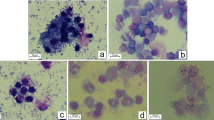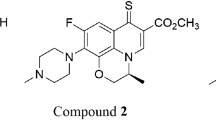Abstract
It is becoming increasingly evident that certain phytochemicals possess cancer chemopreventive properties. In this study, the anti-proliferative activity of plant extracts from olive (Olea europaea L.) leaves was tested on human leukemic cell line (Jurkat). Cytotoxicity of various concentrations of plant extracts was examined and the IC50 was determined. Olive leaf extracts showed concentration-dependent anti-proliferative effect as determined by the WST-1 proliferation kit and [3H]-thymidine incorporation method. To study whether cell death was due to apoptosis, cells were stained with Annexin V-FITC and PI and the expression of important regulatory proteins (Bcl-2, Bax, and p53) involved in apoptosis were examined by Western blot. The antioxidant activity of olive leaves (SC50 = 0.1 mg dry weight) was studied using the DPPH scavenging method. Present findings suggest that olive leaves extracts exhibit anti-proliferative effect on leukemic cells by inducing apoptosis.




Similar content being viewed by others
Abbreviations
- ALL:
-
acute lymphoblastic leukemia
- IC50 :
-
inhibitory concentration where 50% of the cells die
- OL:
-
Olea europaea
- SC50 :
-
scavenging concentration where 50% of DPPH scavenged
References
Ryan D, Robards K (1998) Phenolic compounds in olives. Analyst 123:31–44
Gilani A, Khan A, Shah A, Connor J, Jabeen Q (2005) Blood pressure lowering effect of olive is mediated through calcium channel blockade. Int J Food Sci Nutr 56(8):613–620
Nicoli MC, Anese M, Parpinel M (1999) Influence of processing on the antioxidant properties of fruit and vegetables. Trends Food Sci Tech 10(3):94–100
Duke JA (1992) Handbook of phytochemical constituents of GRAS herbs and other economical plants. CRC, London
Tabera J, Guinda A, Ruiz-Rodriguez A, Señoráns FJ, Ibáñez E, Albi T, Reglero G (2004) Countercurrent supercritical fluid extraction and fractionation of high-added-value compounds from a hexane extract of olive leaves. J Agric Food Chem 52(15):4774–4779
Soler-Rivas C, Espin J, Wichers H (2000) Oleuropein and related compounds. J Sci Food Agric 80:1013–1023
Japón-Luján R, Ruiz-Jiménez J, Luque de Castro MD (2006) Discrimination and classification of olive tree varieties and cultivation zones by biophenol contents. J Agric Food Chem 54(26):9706–12
Cheung SC, Szeto YT, Benzie IF (2007) Antioxidant protection of edible oils. Plant Foods Hum Nutr 62(1):39–42
Le Tutour B, Guedon D (1992) Antioxidative activities of Olea europea L. leaves and related phenolic compounds. Phytochemistry 31(4):1173
Sreelatha S, Padma PR (2009) Antioxidant activity and total phenolic content of Moringa oleifera leaves in two stages of maturity. Plant Foods Hum Nutr 64(4):303–311
Saito K, Kohno M, Yoshizaki F, Niwano Y (2008) Extensive screening for edible herbal extracts with potent scavenging activity against superoxide anions. Plant Foods Hum Nutr 63(2):65–70
Abaza L, Talorete T, Yamada P, Kurita Y, Zarrouk M, Isoda H (2007) Induction of growth inhibition and differentiation of human leukemia HL-60 cells by a Tunisian Gerboui olive leaf extract. Biosci Biotechnol Biochem 71(5):1306–1312
Reyes F, Centelles J, Lupianez J, Cascante M (2006) (2α, 3β)-2, 3-Dihydroxyolean-12-en-28-oic acid, a new natural triterpene from Olea europea, induces caspase dependent apoptosis selectively in colon adenocarcinoma cells. FEBS Lett 580(27):6302–6310
Littlefield JW, Gould EA (1960) The toxic effect of 5-Bromodeoxyuridine on cultured epithelial cells. J Biol Chem 235:1129–1133
Roshak AK, Capper EA, Stevenson C, Eichman C, Marshall LA (2000) Human calcium-independent phospholipase A2 mediates lymphocyte proliferation. J Biol Chem 275(46):35692–35698
Vermes I, Haanen C, Steffens-Nakken H, Reutelingsperger C (1995) A novel assay for apoptosis: Flow cytometric detection of phosphatidylserine expression on early apoptotic cells using fluorescein labeled Annexin V. J Immunol Methods 184(1):39–51
Del Bino G, Darzynkiewicz Z, Degraef C, Mosselmans R, Fokan D, Galand P (1999) Comparison of methods based on annexin-V binding, DNA content or TUNEL for evaluating cell death in HL-60 and adherent MCF-7 cells. Cell Prolif 32(1):25–37
Singleton VL, Rossi JA (1965) Colorimetry of total phenolics with phosphomolybdic-phosphotungstic acid reagents. Am J Enol Vitic 16(3):144–158
Kahkonen MP, Hopia AI, Vuorela HJ, Rauha JP, Pihlaja K, Kujala TS, Heinonen M (1999) Antioxidant activity of plant extracts containing phenolic compounds. J Agric Food Chem 47(10):3954–3962
Hou W, Lee M, Chen H, Liang W, Han C, Liu Y, Lin Y (2001) Antioxidant activities of dioscorin, the storage protein of yam (Dioscorea batatas Decne). J Agric Food Chem 49(10):4956–4960
Foley G, Lazarus H, Farber S, Uzman BG, Boone BA, McCarthy RE (1965) Continuous culture of human lymphoblasts from peripheral blood of a child with acute leukemia. Cancer 10:522–529
Micol V, Caturla N, Pérez-Fons L, Mas V, Pérez L, Estepa A (2005) The olive leaf extract exhibits antiviral activity against haemorrhagic septicemia rhabdovirus (VHSV). Antiviral Res 66(2–3):129–136
Harakeh S, Diab-Assaf M, Niedzweicki A, Khalife J, Abu-El-Ardat K, Rath M (2006) Apoptosis induction by epican forte in HTLV-1 positive and negative malignant T-cells. Leuk Res 30(7):869–881
Nousis L, Doulias PT, Aligiannis N, Bazios D, Agalias A, Galaris D, Mitakou S (2005) DNA protecting and genotoxic effects of olive oil related components in cells exposed to hydrogen peroxide. Free Radic Res 39(7):787–795
Kohyama N, Nagata T, Fujimoto S, Sekiya K (1997) Inhibition of arachidonate lipoxygenase activities by 2-(3, 4-dihydroxyphenyl) ethanol, a phenolic compound from olives. Biosci Biotechnol Biochem 61(2):347–350
Manna C, Galletti P, Cucciolla V, Moltedo O, Leone A, Zappia V (1997) The protective effect of the olive oil polyphenol (3, 4-dihydroxyphenyl)-ethanol counteracts reactive oxygen metabolite-induced cytotoxicity in Caco-2 cells. J Nutr 127(2):286–292
Saija A, Trombetta D, Tomaino A, Lo Cascio R, Princi P, Uccella N, Bonina F, Castelli F (1998) In vitro evaluation of the antioxidant activity and biomembrane interaction of the plant phenols oleuropein and hydroxytyrosol. Int J Pharmaceut 166(2):123–133
Visioli F, Galli C (1994) Oleuropein protects low density lipoprotein from oxidation. Life Sci 55(24):1965–1971
Acknowledgements
We would like to thank Mr. Michel Zakhem for his technical support.
Author information
Authors and Affiliations
Corresponding author
Rights and permissions
About this article
Cite this article
Fares, R., Bazzi, S., Baydoun, S.E. et al. The Antioxidant and Anti-proliferative Activity of the Lebanese Olea europaea Extract. Plant Foods Hum Nutr 66, 58–63 (2011). https://doi.org/10.1007/s11130-011-0213-9
Published:
Issue Date:
DOI: https://doi.org/10.1007/s11130-011-0213-9




